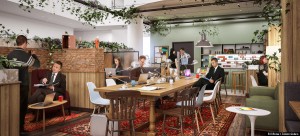
Over a decade ago tenants began building out office space in a much more open environment. This included less private offices in order to maximize density and increase collaboration. These days we rarely come across tall cubicles, as most workstations have dividers that reach no higher than a standard monitor. Some workstations are divided by nothing at all.
How do the actual occupants in today’s open office environments feel about their workspace and is there anything a project team can do to improve the conditions?
Harvard Business Review did research on how employees working in today’s small footprint workstations felt about their environment.
Despite the fact the results of the data showed that people in open office space might not be as cheerfully happy as we thought they were, the data was fascinating in the sense of how proper planning can improve the occupant experience. The top five complaints about today’s high-density open style office space were:
1. Sound Privacy
2. Noise
3. Temperature
4. Visual Privacy
5. Air Quality
Contrary to what one would expect, “Amount of Space” was not part of the top five list of complaints (it was #6). The good news is that if the project team considers these items in advance, they can mitigate future occupancy complaints. Outlined below are ways to tackle these problems before they present themselves:
1. Sound Privacy – Tenants should dedicate small “phone booth” size rooms or other quite spaces in the office for their staff to be able to field important phone calls, host one-on-one meetings, or conduct conference calls.
2. Noise – This common problem can be solved by a few techniques. The most costly, but often most effective, is through acoustical treatment of the ceiling and walls – most commonly insulated paneling. Another approach is installing an audio soundproofing speaker system to produce a white noise that allows people to focus. The least expensive, that may or may not work for all industries, is offering a nice pair of sound canceling headsets for everyone.
3. Temperature (and 5. Air Quality) – Tenants converting second generation office space that was previously used for a lower density often ignore the fact that the HVAC needs to be accommodated to meet the greater head count. Equipment and controls need to be engineered to match the occupancy to ensure that the air temperature and air volume are what they should be.
4. Visual Privacy – Some office spaces are desk arrangements without panels where employees would be looking directly at each other in the eyes if there weren’t computer monitors in the way. By working closely with a furniture vendor early in the process, creative approaches can be developed in which employees are not facing each other head-on.





